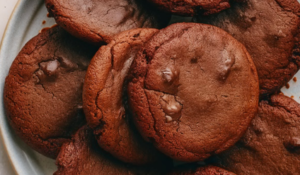Introduction
When you eagerly anticipate baking a batch of delicious brownie cookies, only to be disappointed by them coming out flat, it can be quite disheartening. Brownie cookies, known for their rich, chocolatey flavor and chewy texture, should be thick and satisfying. If yours are turning out flat, there are several potential reasons why this might be happening. This article will delve into the common causes of flat brownie cookies, how to prevent it, and additional tips to ensure your cookies turn out perfectly every time.
Understanding the Ingredients
The key to great brownie cookies lies in understanding the role of each ingredient in the recipe. Each component works in harmony to create the desired texture and flavor. Let’s explore the main ingredients and their functions:
Flour
Flour provides structure to your cookies. The type of flour and the amount used can significantly impact the outcome. All-purpose flour is commonly used for brownie cookies, but using too little can cause the cookies to spread too much and become flat.
Butter
Butter adds flavor and richness. It also plays a crucial role in the cookie’s texture. Too much butter can cause the cookies to spread excessively, leading to flat cookies. Ensuring the butter is at the right temperature is also important – too soft or melted butter can result in flat cookies.
Sugar
Sugar not only sweetens the cookies but also affects their texture. Brown sugar contributes to chewiness, while white sugar helps cookies spread. The balance between these sugars is crucial for the perfect brownie cookie.
Eggs
Eggs bind the ingredients together and add moisture. However, using too many eggs can make the batter too runny, causing the cookies to spread too much.
Chocolate
The type of chocolate used can also influence the cookie’s texture. Melted chocolate and cocoa powder both contribute to the rich flavor and can affect how much the cookies spread.
Leavening Agents
Baking soda or baking powder helps the cookies rise. Too little leavening can cause dense, flat cookies, while too much can make them spread too much and become flat.
Common Reasons for Flat Brownie Cookies
1. Incorrect Measurements
Baking is a science, and accurate measurements are essential. Too much or too little of any ingredient can affect the final result. Always use a kitchen scale for precise measurements.
2. Overmixing the Dough
Overmixing can incorporate too much air into the dough, causing the cookies to collapse and become flat. Mix the ingredients just until they are combined to avoid this.
3. Oven Temperature Issues
An oven that is too hot can cause the cookies to spread too quickly before they have a chance to set, resulting in flat cookies. Always preheat your oven and use an oven thermometer to ensure it’s at the correct temperature.
4. Butter Temperature
Butter that is too warm or melted can cause the cookies to spread too much. It’s best to use softened butter, which should be cool to the touch but pliable.
5. Insufficient Chilling Time
Chilling the dough helps to solidify the fat, preventing the cookies from spreading too much during baking. If the dough is not chilled, the cookies can spread out too quickly.
How to Prevent Flat Brownie Cookies

Measure Accurately
Use a kitchen scale to ensure you are using the correct amount of each ingredient. This precision can make a significant difference in the final result.
Avoid Overmixing
Mix the ingredients until they are just combined. Overmixing can cause the dough to become too airy, leading to flat cookies.
Use Proper Oven Temperature
Preheat your oven and use an oven thermometer to ensure it’s at the correct temperature. Bake the cookies at the specified temperature in the recipe to prevent spreading.
Chill the Dough
Chill the dough for at least 30 minutes before baking. This helps to solidify the fat and prevent the cookies from spreading too much.
Check Butter Temperature
Use softened butter, not melted butter. Softened butter should be cool to the touch but still pliable.
Additional Tips for Perfect Brownie Cookies
Use Parchment Paper or Silicone Mats
Lining your baking sheets with parchment paper or silicone mats can prevent the cookies from spreading too much. These surfaces provide a bit of grip, keeping the cookies in place.
Experiment with Baking Times
Baking times can vary depending on your oven and the size of your cookies. Start checking your cookies a few minutes before the suggested baking time to avoid overbaking, which can cause them to spread and become flat.
Add Extra Egg Yolk
If your cookies are still too flat, try adding an extra egg yolk to the dough. The additional fat and protein can help create a thicker, chewier cookie.
Avoid Warm Baking Sheets
Using warm baking sheets can cause the dough to start melting before it even gets into the oven, leading to flat cookies. Always use cool baking sheets when placing the dough.
Adjust Flour Type
Consider using bread flour instead of all-purpose flour. Bread flour has a higher protein content, which can help create a thicker, chewier cookie.
Try Different Chocolate
Experiment with different types of chocolate. Using a combination of melted chocolate and cocoa powder can provide a rich flavor and help control the cookie’s spread.
The Science Behind Perfect Brownie Cookies
Understanding the science behind each ingredient and its interaction can help you troubleshoot and perfect your brownie cookie recipe. Here are some scientific insights:
The Role of Fat
Fat, primarily from butter, contributes to the spread and texture of the cookies. When fat melts during baking, it creates steam and causes the cookies to rise. However, if the fat is too warm or too much is used, the cookies can spread too quickly and become flat.
The Importance of Temperature
The temperature of your ingredients and your oven plays a crucial role. Cold dough spreads less, leading to thicker cookies, while a too-hot oven can cause rapid spreading. Ensuring everything is at the right temperature is key to achieving the desired texture.
Sugar and Caramelization
Sugar affects the spread and browning of the cookies. Brown sugar, which contains molasses, adds moisture and chewiness, while white sugar promotes spreading and crisping. Balancing these sugars can help control the cookie’s texture.
Gluten Development
Flour provides structure through gluten development. Overmixing can cause too much gluten formation, leading to tough cookies that may spread too much. Mixing just until combined ensures a tender, chewy texture.
Personal Anecdotes and Tips
As a passionate home baker, I’ve had my fair share of flat brownie cookies. One memorable occasion was when I was baking for a friend’s birthday party. Despite following the recipe, the cookies came out disappointingly flat. After some troubleshooting, I realized my butter was too warm, and my oven temperature was off. I made the necessary adjustments, and the next batch turned out perfectly. Here are some personal tips to ensure success:
Invest in Quality Tools
Having reliable kitchen tools, such as a kitchen scale, an oven thermometer, and a stand mixer, can make a significant difference in your baking results. Accurate measurements and consistent mixing can prevent many common issues.
Test Your Oven
Ovens can have hot spots and vary in temperature. Conduct a test by baking a few cookies at different spots in your oven to see if there are any inconsistencies. This can help you adjust your baking times and temperatures accordingly.
Experiment with Flavors
Don’t be afraid to experiment with different flavors and add-ins. Incorporating nuts, dried fruit, or different types of chocolate can add variety and texture to your brownie cookies.
The History and Cultural Significance of Brownie Cookies
Brownie cookies are a delightful fusion of two beloved desserts: brownies and cookies. Brownies originated in the United States in the late 19th century, and their chewy, chocolatey goodness quickly became popular. Cookies have a much older history, dating back to ancient Persia.
The combination of these two desserts into brownie cookies is a relatively recent innovation, reflecting the ongoing creativity in baking. These cookies are beloved for their rich flavor and unique texture, making them a popular choice for special occasions and everyday treats.
Variations from Around the World
American Brownie Cookies
In the United States, brownie cookies often feature a combination of melted chocolate and cocoa powder, resulting in a rich, fudgy texture. They are sometimes topped with a sprinkle of sea salt for a sweet-salty contrast.
French Chocolate Sables
In France, a similar cookie known as a “sable” is popular. These cookies are typically made with high-quality European butter and chocolate, resulting in a delicate, crumbly texture.
Italian Biscotti al Cioccolato
Italy offers its version with “biscotti al cioccolato,” which are twice-baked, resulting in a crisp, crunchy texture. These cookies often include nuts and are perfect for dipping in coffee or wine.
Pairings and Serving Suggestions
Beverage Pairings
Brownie cookies pair wonderfully with a variety of beverages. A glass of cold milk is a classic choice, but they also go well with coffee, hot chocolate, or even a rich, full-bodied red wine like Cabernet Sauvignon.
Ice Cream Sandwiches
For a decadent treat, use brownie cookies to make ice cream sandwiches. Simply sandwich a scoop of your favorite ice cream between two cookies and enjoy!
Whipped Cream and Berries
Serve brownie cookies with a dollop of whipped cream and a handful of fresh berries for an elegant dessert. The tartness of the berries complements the rich, chocolatey flavor of the cookies.
Storing and Preserving Brownie Cookies
Short-Term Storage
Store brownie cookies in an airtight container at room temperature for up to a week. Place a piece of parchment paper between layers to prevent them from sticking together.
Freezing
Brownie cookies can be frozen for longer storage. Place them in a single layer on a baking sheet and freeze until solid. Then, transfer them to a freezer-safe bag or container. They can be stored for up to three months. Thaw at room temperature before serving.
Dough Freezing
You can also freeze the cookie dough. Scoop the dough onto a baking sheet and freeze until solid. Transfer the frozen dough balls to a freezer-safe bag. Bake directly from frozen, adding a couple of extra minutes to the baking time.
User Testimonials
Sarah M.
“I’ve struggled with flat brownie cookies for years, but after following these tips, my cookies finally turned out perfect! Chilling the dough and using a kitchen scale made all the difference.”
John D.
“These troubleshooting tips saved my holiday baking. My brownie cookies were always flat and disappointing, but now they’re thick, chewy, and delicious. Thank you!”
Emily R.
“I love experimenting with different chocolate types and add-ins. The tips in this article helped me understand how to adjust my recipe for the best results. My cookies have never been better!”
Conclusion
Achieving the perfect brownie cookies requires a balance of science and artistry. By understanding the role of each ingredient, measuring accurately, and paying attention to temperature, you can avoid flat cookies and enjoy thick, chewy, chocolatey delights every time. Remember to chill your dough, use softened butter, and experiment with different variations to find your ideal recipe. With these tips and a bit of practice, you’ll be able to bake brownie cookies that are sure to impress.

